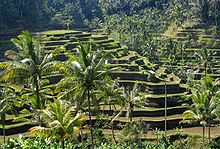Subak (irrigation community)
| Cultural landscape of the province of Bali: The Subak system as a manifestation of the Tri Hita Karana philosophy | |
|---|---|
|
UNESCO world heritage |
|

|
|
| Rice cultivation in Bali with irrigated terrace |
|
| National territory: |
|
| Type: | Culture |
| Criteria : | ii, iii, v, vi |
| Reference No .: | 1194 |
| UNESCO region : | Asia and Pacific |
| History of enrollment | |
| Enrollment: | 2012 (session 36) |


Subak ( Balinese , "Irrigation Community" or "Irrigation Cooperative ") is a rural organization on the Indonesian island of Bali that provides the legal and practical framework for growing wet rice. A subak includes the association of landowners, a number of terraced rice fields ( sawah ) and the irrigation system required for this .
Five Balinese Subak landscapes were added to the UNESCO World Heritage List in 2012.
history
The Subaks were finally introduced in 1022 by royal edict. Originally the term Subak only describes the irrigation system of the rice terraces, which are irrigated via a canal (bal.) Telabah gde or dam (bal.) Empelan . Subak literally means connected water .
The first Subak were probably built at springs, because the rivers in Bali can only be used for irrigation with considerable engineering structures due to their poor accessibility in deeply cut valleys. Because of their importance, these springs were given temples early on. Subak had a religious aspect from ovo .
Later, after the first successful tunnel construction, rivers were also opened up using irrigation tunnels. Furthermore, more and more canals and aqueducts were created for the further use of surpluses. When a sawah ( wet rice field ) is full, it needs little water, and when it is drained to ripen the rice, it does not need any. In the course of the green revolution of the late 1960s and early 1970s, the Subaks found themselves in various crisis situations.
organization
The landowners of the associated rice fields are known as members of the Subak. The klian (chairman) is elected as required by the general assembly of members.
In terms of settlement, the Subak is not a settlement unit, but an agricultural community. The limits of a Subak result quite physically from the inlet to a spring or a large canal and all attached irrigated areas. The settlement community is called (bal.) Banjar . This village or settlement community can be located in several Subak, and vice versa, a Subak can consist of properties from different Banjar.
In the "rice chamber of Bali", in the village of Sanggulan, Tabanan district , there is a museum worth seeing.
Subak and the water temples above it are an eminent example of human self-organization . With the superordinate levels of the water temple, a fractal organization results for the irrigation system of a watershed . By controlling the cultivation plans, this leads to management optimized for the limiting factors of water scarcity and pest infestation .
literature
- J. Stephen Lansing: Priests and Programmers: Technology of Power in the Engineered Landscape of Bali Princeton University Press.
- Balinese Water Temples Withstand Tests of Time and Technology . National Science Foundation
- J. Stephen Lansing: Simulation Modeling of Balinese Irrigation (extract). In: J. Mabry (Ed.): Canals and Communities: Small-scale Irrigation Systems. University of Arizona Press, Tucson 1996, pp. 139-156
- Jonathan Sepe: The Impact of the Green Revolution and Capitalized Farming on the Balinese Water Temple System . 2000
- Aubrey W. Birkelbach, Jr .: The Subak Association. In: Indonesia 16, October 1973, pp. 153-169
Individual evidence
- ↑ "The soebak (writing in 1941) Likewise, what to extension of the democratic method, for membership in it what compulsory, and though a headman what elected by the majority, hey what Compelled to serve even though he might prefer not to." Phillip H. Hiss: Bali . Duel, Sloan & Pearce, NY, 1941
- ↑ Helmut Uhlig: Life with Gods: Festivals on Bali. Nuremberg 1995, p. 104
- ↑ UNESCO World Heritage Center: Cultural Landscape of Bali Province: the Subak System as a Manifestation of the Tri Hita Karana Philosophy
- ^ Bedrich Forman, Rudolf Mrázek, Werner Forman: Bali - The Split Gate To Heaven . Orbis, London 1983, p. 35, ISBN 0-85613-513-5
- ^ A b Clifford Geertz : Organization of the Balinese Subak . In: Walter Coward: Irrigation and Agricultural Development in Asia: Perspectives from the Social Sciences . Cornell University Press, September 1980, pp. 79ff, ISBN 0-8014-1132-7
- ^ Bedrich Forman, Rudolf Mrázek, Werner Forman: Bali - The Split Gate To Heaven . Orbis, London 1983, p. 124, ISBN 0-85613-513-5
- ^ J. Stephen Lansing: Priests and Programmers: Technology of Power in the Engineered Landscape of Bali. Princeton University Press, especially chapters one and six
- ↑ - ( Memento of the original from May 11, 2012 in the Internet Archive ) Info: The archive link has been inserted automatically and has not yet been checked. Please check the original and archive link according to the instructions and then remove this notice.
- ↑ http://www.indo.com/featured_article/subak.html
- ↑ Archived copy ( Memento of the original from May 22, 2010 in the Internet Archive ) Info: The archive link was inserted automatically and has not yet been checked. Please check the original and archive link according to the instructions and then remove this notice.
- ^ J. Stephen Lansing: Priests and Programmers: Technology of Power in the Engineered Landscape of Bali. Princeton University Press, especially chapters one and six
